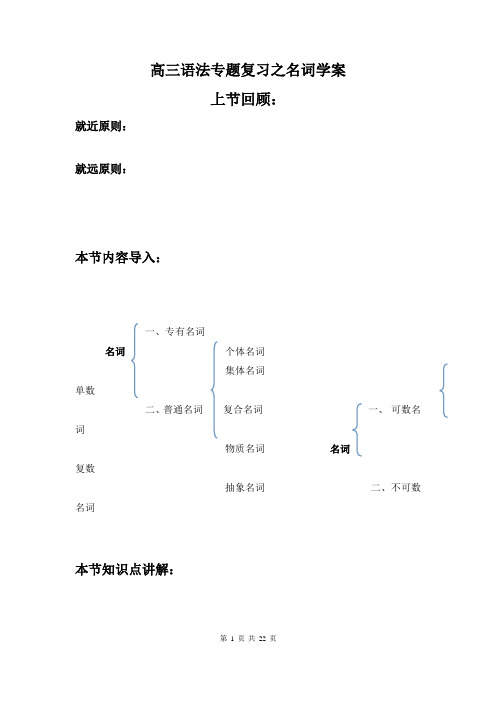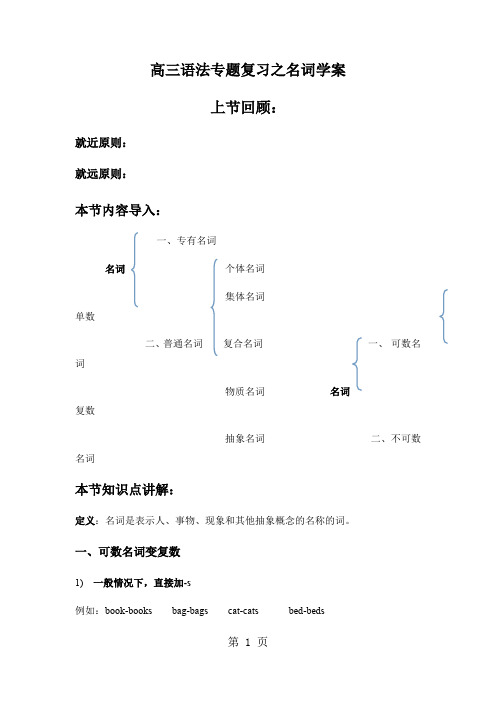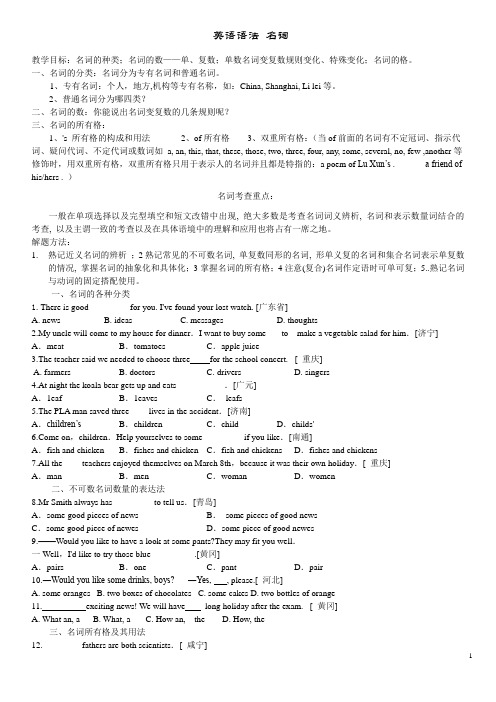高三英语语法知识名词复习教案
- 格式:doc
- 大小:19.03 KB
- 文档页数:4

教学对象:高中一年级学生教学目标:1. 知识目标:学生能够掌握名词的基本概念和分类,了解可数名词和不可数名词的区别。
2. 能力目标:学生能够正确使用名词进行日常对话和写作,提高语言表达能力。
3. 情感目标:激发学生对英语学习的兴趣,培养学生良好的学习习惯。
教学重点:1. 名词的分类及区别。
2. 名词在句子中的用法。
教学难点:1. 可数名词和不可数名词的区分。
2. 名词在句子中的正确运用。
教学准备:1. 教学课件2. 名词卡片3. 词汇练习册4. 练习题教学过程:一、导入1. 教师通过图片或实物展示,引导学生说出名词。
2. 提问:名词有哪些特点?它们在句子中有什么作用?二、新课讲授1. 名词的概念:名词是表示人、事物、地点或抽象概念等的词。
2. 名词的分类:a. 可数名词:表示可以数的事物,如:book、pen、apple。
b. 不可数名词:表示无法数的事物,如:water、air、money。
3. 可数名词和不可数名词的区别:a. 可数名词有复数形式,不可数名词没有。
b. 可数名词可以用不定冠词a/an修饰,不可数名词不能。
4. 名词在句子中的用法:a. 主语:The boy is playing football.b. 谓语:I like apples.c. 宾语:She bought a book.d. 定语:A red car is parked outside.三、课堂练习1. 教师出示名词卡片,学生根据卡片内容进行分类。
2. 学生根据所学知识,完成词汇练习册中的名词练习题。
四、小组讨论1. 学生分为小组,讨论以下问题:a. 如何区分可数名词和不可数名词?b. 名词在句子中的用法有哪些?2. 小组代表进行发言,教师点评。
五、总结1. 教师对本节课所学内容进行总结,强调重点和难点。
2. 学生复述名词的概念、分类、区别和用法。
六、布置作业1. 完成词汇练习册中的名词练习题。
2. 预习下一节课内容。

高三语法专题复习之名词学案上节回顾:就近原则:就远原则:本节内容导入:一、专有名词名词个体名词集体名词单数二、普通名词复合名词一、可数名词物质名词名词复数抽象名词二、不可数名词本节知识点讲解:定义:名词是表示人、事物、现象和其他抽象概念的名称的词。
一、可数名词变复数1) 一般情况下,直接加-s例如:book-books bag-bags cat-cats bed-beds2) 以s. x. sh. ch结尾,加-es,读作【iz】例如:bus-buses box-boxes watch-watches brush-brushes3)以“辅音字母+y”结尾,变y为i,再加-es.例如:family-families strawberry-strawberries library-librariesdictionary-dictionaries而以“元音字母+y”结尾,直接加s:toy- toys monkey-monkeys4) 以“f或fe”结尾,变f或fe为v,再加-es,例如:wife-wives life-lives self-selves knife-knives leaf-leaves thief-thieves half-haves self-selves shelf-shelves loaf-loaves wolf-wolves等。
巧记忆:勇敢的妻子(wife),拿了一把刀(knife),自己(self)把狼(wolf)杀死了,救回小牛(calf)半(half)条命(life),又把躲在葡萄架子(shelf)的叶子(leaf)中的小偷(thief)抓住了也有直接加s的单词:roof-roofs belief-beliefs proof-proofs chief-chiefs 5) 以o结尾,大部分情况下直接加s,但是有特殊情况:例如:hero-heroes tomato-tomatoes potato-potatoes (英雄爱吃西红柿和土豆)piano-pianos photo-photos6) 特殊变化的名词:例如:man-men woman-women policeman-policemenpolicewoman-policewomen mouse-mice(老鼠) child-children foot-feettooth-teeth7) 单复数同形的名词:例如:fish鱼deer鹿sheep绵羊works(工厂)means手段8) 复合名词变复数通常是将其主要名词变为复数;例如:passer-by变为passers-by 过路人looker-on 变为lookers-by 旁观者注意:一些以man, woman 结尾的合成词,在变复数时与man, woman 的变化形式相同。

教学过程一、复习预习教师引导学生复习上节课所学的知识点,(以提问、回顾的形式进行),针对上节课的作业进行讲评、订正、答疑二、知识讲解考点/易错点1 名词的数名词分为可数(有单、复数形式)和不可数名词(只有单数形式)。
1、可数名词单数变复数:①一般加s :lesson → lessons, pen → pens②以s, x, ss, ch, sh, o结尾的加es :buses, boxes, classes, watches, brushes, hero → heroes但有些以o结尾的名词,是加s构成复数:kilo → kilos, piano → pianos, radio → radios,photo → photos, zoo → zoos③以辅音字母+ y 结尾的改y为i,再加es :city → cities, story → stories④以f 或fe结尾的,一般将f或fe改为v,再加es :knife → knives, leaf → leaves 但有些以f 结尾的名词,是在f后加s,构成复数形式:belief → beliefs, roof → roofs, safe(保险箱)→ safes, proof(证据)→ proofs, chief → chiefs, handkerchief → handkerchiefs2、有些名词,不按上述规则构成其复数形式,有以下几种情况:①单复数形式相同:Chinese, Japanese, deer, sheep②不规则变化:man → men, woman → women, goose → geese, foot → feet, tooth → teeth, child → children, mouse → mice, ox → oxen 。
但是,German → Germans ③复合名词的复数形式:editor-in-chief → editors-in-chief, daughter-in-law → daughters-in-law, grown-up → grown-ups, woman teacher → women teachers, man driver → men drivers3、注意以下几个名词单复数问题①物质名词一般不用复数形式,但有些物质名词要用复数形式来表示不同的类别,如:fishes各种鱼,fruits各种水果,steels各种钢材。

高中英语名词复习教学设计一、教学目标通过本教学设计,学生将能够:1. 复习并巩固高中英语中常见的名词形式和用法;2. 能够正确运用名词进行交流和表达;3. 提高学生对名词的理解和运用能力。
二、教学重点和难点1. 教学重点:(1) 复习和巩固名词的基本概念和分类;(2) 掌握名词的复数形式和不规则变化;(3) 学习名词在句子中的基本用法和修饰方式。
2. 教学难点:(1) 名词的复数形式的不规则变化;(2) 名词的用法和修饰方式的深入理解。
三、教学过程第一课时:名词基础知识的复习一、名词的基本概念和分类1. 通过引导学生回顾名词的定义和特点,巩固对名词的基本概念的理解;2. 分类:可数名词和不可数名词的区分及其特点。
二、名词的复数形式1. 正规复数形式的变化规则:一般在名词末尾加-s或-es;2. 不规则复数形式的变化规则:部分名词变化不规则,需要进行重点强化训练。
第二课时:名词用法和修饰方式的学习一、名词在句子中的基本用法1. 单数名词作主语时的用法;2. 复数名词作主语时的用法;3. 名词作宾语、表语和定语的用法。
二、名词的修饰方式1. 名词前的冠词的用法和选择;2. 名词前的形容词的用法和选择;3. 名词前的限定词的用法和选择。
第三课时:名词的运用和综合应用一、名词的运用1. 运用所学的名词知识进行简单的语言交流;2. 运用所学的名词知识进行写作练习。
二、名词的综合应用1. 综合练习:通过配对、填空、选择等形式,巩固名词的基本知识;2. 拓展应用:通过阅读材料或听力训练,让学生将名词的知识应用到实际情境中。
四、教学方法1. 情景教学法:通过创设情境,激发学生的学习兴趣和参与度;2. 基于任务的学习法:通过任务型练习,培养学生的语言运用能力;3. 合作学习法:通过小组合作或同伴交流的方式,促进学生之间的互动和合作。
五、教学评估1. 在教学过程中,及时进行个别或全班的口头评价,查看学生对名词知识的掌握情况;2. 综合评价:通过名词的应用练习和综合应用,对学生的名词理解和运用能力进行评估。

高三语法专题复习之名词学案上节回顾:就近原则:就远原则:本节内容导入:一、专有名词名词个体名词集体名词单数二、普通名词复合名词一、可数名词物质名词名词复数抽象名词二、不可数名词本节知识点讲解:定义:名词是表示人、事物、现象和其他抽象概念的名称的词。
一、可数名词变复数1) 一般情况下,直接加-s例如:book-books bag-bags cat-cats bed-beds2) 以s. x. sh. ch结尾,加-es,读作【iz】例如:bus-buses box-boxes watch-watches brush-brushes3)以“辅音字母+y”结尾,变y为i,再加-es.例如:family-families strawberry-strawberries library-librariesdictionary-dictionaries而以“元音字母+y”结尾,直接加s:toy- toys monkey-monkeys4) 以“f或fe”结尾,变f或fe为v,再加-es,例如:wife-wives life-lives self-selves knife-knives leaf-leaves thief-thieves half-haves self-selves shelf-shelves loaf-loaves wolf-wolves等。
巧记忆:勇敢的妻子(wife),拿了一把刀(knife),自己(self)把狼(wolf)杀死了,救回小牛(calf)半(half)条命(life),又把躲在葡萄架子(shelf)的叶子(leaf)中的小偷(thief)抓住了也有直接加s的单词:roof-roofs belief-beliefs proof-proofs chief-chiefs 5) 以o结尾,大部分情况下直接加s,但是有特殊情况:例如:hero-heroes tomato-tomatoes potato-potatoes (英雄爱吃西红柿和土豆)piano-pianos photo-photos6) 特殊变化的名词:例如:man-men woman-women policeman-policemenpolicewoman-policewomen mouse-mice(老鼠) child-children foot-feettooth-teeth7) 单复数同形的名词:例如:fish鱼deer鹿sheep绵羊works(工厂)means手段8) 复合名词变复数通常是将其主要名词变为复数;例如:passer-by变为passers-by 过路人looker-on 变为lookers-by 旁观者注意:一些以man, woman 结尾的合成词,在变复数时与man, woman 的变化形式相同。

英语语法名词教学目标:名词的种类;名词的数——单、复数;单数名词变复数规则变化、特殊变化;名词的格。
一、名词的分类:名词分为专有名词和普通名词。
1、专有名词:个人,地方,机构等专有名称,如:China, Shanghai, Li lei等。
2、普通名词分为哪四类?二、名词的数:你能说出名词变复数的几条规则呢?三、名词的所有格:1、's 所有格的构成和用法2、of所有格3、双重所有格:(当of前面的名词有不定冠词、指示代词、疑问代词、不定代词或数词如a, an, this, that, these, those, two, three, four, any, some, several, no, few ,another等修饰时,用双重所有格,双重所有格只用于表示人的名词并且都是特指的:a poem of Lu Xun’s . a friend of his/hers . )名词考查重点:一般在单项选择以及完型填空和短文改错中出现, 绝大多数是考查名词词义辨析, 名词和表示数量词结合的考查, 以及主谓一致的考查以及在具体语境中的理解和应用也将占有一席之地。
解题方法:1.熟记近义名词的辨析;2熟记常见的不可数名词, 单复数同形的名词, 形单义复的名词和集合名词表示单复数的情况, 掌握名词的抽象化和具体化;3掌握名词的所有格;4注意(复合)名词作定语时可单可复;5..熟记名词与动词的固定搭配使用。
一、名词的各种分类1.There is good_________ for you. I've found your lost watch. [广东省]A. newsB. ideasC. messagesD. thoughts2.My uncle will come to my house for dinner.I want to buy some ___to make a vegetable salad for him.[济宁] A.meat B.tomatoes C.apple juice3.The teacher said we needed to choose three for the school concert. [ 重庆]A. farmersB. doctorsC. driversD. singers4.At night the koala bear gets up and eats___________.[广元]A.1eaf B.1eaves C.leafs5.The PLA man saved three ____lives in the accident.[济南]A.children’s B.children C.child D.childs'e on,children.Help yourselves to some_________ if you like.[南通]A.fish and chicken B.fishes and chicken C.fish and chickens D.fishes and chickens7.All the ____teachers enjoyed themselves on March 8th,because it was their own holiday.[ 重庆]A.man B.men C.woman D.women二、不可数名词数量的表达法8.Mr Smith always has _________to tell us.[青岛]A.some good pieces of news B.some pieces of good newsC.some good piece of newes D.some piece of good newes9.——Would you like to have a look at some pants?They may fit you well.一Well,I'd like to try those blue__________.[黄冈]A.pairs B.one C.pant D.pair10.―Would you like some drinks, boys?―Yes,, please.[ 河北]A. some orangesB. two boxes of chocolatesC. some cakesD. two bottles of orange11. exciting news! We will have long holiday after the exam. [ 黄冈]A. What an, aB. What, aC. How an, theD. How, the三、名词所有格及其用法12._________fathers are both scientists.[ 咸宁]A.Jim's and Bob B.Jim's and Bob's C.Jim and Bob's D.Jim and Bob13._____room is big and bright.They like it very much.[河北]A.Tom and Sam B.Tom's find Sam C.Tom and Sam's D.Tom's and Sam's14.―How’s Joy’s skirt?―Her skirt is more beautiful than. [ 兰州]A. her sister’s and KateB. her sister and KateC. her sister and Kate’sD. her sister’s and Kate’s四、表示时间、距离、国家、城市、团体、机构等无生命东西的名词,也可以加“'s”来构成所有格。
英语名词知识点归纳教案教案标题:英语名词知识点归纳教案教案目标:1. 通过归纳整理英语名词的知识点,帮助学生加深对名词的理解和掌握。
2. 培养学生对名词的分类和归纳能力,提高学生的学习效率和记忆能力。
3. 引导学生通过实例分析和练习,巩固对名词的应用能力。
教学步骤:第一步:导入(5分钟)1. 创设情境,引起学生对名词的兴趣。
2. 提问学生对名词的理解和定义。
第二步:名词分类(10分钟)1. 分类介绍名词的基本分类:可数名词和不可数名词。
2. 通过图示和实例,让学生理解和区分可数名词和不可数名词的特点。
3. 指导学生进行名词分类练习,巩固对可数名词和不可数名词的掌握。
第三步:名词的单复数形式(15分钟)1. 介绍名词的单数和复数形式的规则,如加-s、-es、-ies等。
2. 给出一些常见的名词的单复数形式,让学生进行归纳和总结。
3. 引导学生通过练习,巩固对名词单复数形式的掌握。
第四步:名词所有格(10分钟)1. 介绍名词所有格的概念和用法。
2. 分析名词所有格的形式和规则,如在名词后加-apostrophe和-s等。
3. 给出一些常见的名词所有格的例子,让学生进行归纳和总结。
4. 引导学生通过练习,巩固对名词所有格的掌握。
第五步:名词的用法(15分钟)1. 介绍名词在句子中的不同用法,如主语、宾语、表语、定语等。
2. 通过实例分析和练习,让学生掌握名词在不同句子成分中的用法。
第六步:小结和拓展(5分钟)1. 对本节课所学的名词知识点进行小结和归纳。
2. 鼓励学生进行名词知识的拓展学习,如通过阅读英语文章、做练习题等。
教学资源:1. 名词分类图示和实例图片。
2. 名词单复数形式和名词所有格的规则总结表格。
3. 名词练习题。
教学评估:1. 通过课堂练习和小组讨论,检查学生对名词知识点的掌握情况。
2. 观察学生在练习中的表现和参与度,评估学生的学习效果和理解程度。
拓展活动建议:1. 布置名词相关的练习题,让学生在课后进行巩固和复习。
高三英语语法名词的复习教案一、教学目标1.让学生掌握名词的基本概念、分类和用法。
2.培养学生运用名词进行句子构建的能力。
3.提高学生对名词相关考点的理解和应用。
二、教学内容1.名词的概念和分类2.名词的数和格3.名词的用法4.名词相关考点三、教学过程1.导入师:同学们,我们今天来复习一下名词。
请问大家知道名词是什么吗?生:名词就是表示人、事物、地点、抽象概念等名称的词。
师:很好!那我们就从名词的概念和分类开始吧。
2.名词的概念和分类师:名词分为两大类:可数名词和不可数名词。
可数名词有单数和复数形式,而不可数名词没有复数形式。
请同学们举例说明。
生1:可数名词如:book,table,apple等。
生2:不可数名词如:water,r,rice等。
师:很好!我们来看一下名词的数和格。
3.名词的数和格师:名词的数分为单数和复数。
单数名词通常加“-s”或“-es”变为复数。
但有些名词变复数时需要特殊变化,比如:childchildren,manmen等。
名词的格分为三种:主格、宾格和属格。
主格用于名词作主语,宾格用于名词作宾语,属格用于表示所有关系。
师:请同学们用所学的名词,分别构成单数和复数形式,并说明其格。
生1:bookbooks(主格:Thebookisonthetable.宾格:Ilikethisbook.属格:Thisismybook.)生2:childchildren(主格:Thechildrenareplaying.宾格:Iseethechildren.属格:Thechildren'sbooksarehere.)4.名词的用法师:名词在句子中的用法有很多,比如作主语、宾语、表语、定语等。
请同学们用所学的名词,分别构成不同成分的句子。
生1:主语:Thecatissleeping.生2:宾语:Iboughtabook.生3:表语:Sheisateacher.生4:定语:Thegirl'sbagisred.5.名词相关考点师:在高考英语中,名词的考点主要包括名词的单复数、格、所有格、同义词辨析等。
河南省商丘市第三高级中学高考英语第二轮专项复习《名词》教学设计(一)教学流程Step1 RevisionRevise the language points learned in Module 8 Unit5Step2 Grammar introduction(一)、名词的种类:1、专有名词:1)China, Japan, Beijing, London, Tom, Jack(不加冠词)2)the Great Wall, the Yellow River, the People’s Republic of China,the United States等。
(由普通名词构成的专有名词,要加定冠词。
)2、普通名词:1)不可数名词注意:不可数名词前一般不加冠词,尤不加不定冠词:若加a(an)则使之具体化了。
如:have a wonderful time.不可数名词作主语,谓语动词用第三人称单数形式。
不可数名词一般无复数形式。
部分物质名词在表不同类别时,可用复数形式如:fishes, newspapers, waters, snows……| | | |各种各样的鱼各种报纸河湖、海水积雪有些抽象名词也常用复数,变为可数的具体的事物。
如:times时代,works著作,difficulties困难在表数量时,常用“of”词组来表示。
如:a glass of milk, a cup of tea, two pieces of paper….2)可数名词:可数名词除用复数形式表一类之外,一般都要加冠词:A bird can fly .The frog is a kind of hibernating animal.Vegetables sold at this shop are usually fresh.有复数形式:a)规则变化——加“s”或“es”(与初中同,略)b)不规则变化——child (children), foot (feet), tooth (teeth), man(men),woman (women), mouse (mice), goose (geese), Englishman (Englishmen), phenomenon(phenomena)…注意:c)单、复数同形:sheep, deer, Chinese, Japanese, fish(同一种鱼)……如,a sheep, two sheepd)只用复数形式: thanks, trousers, goods, clothes, socks, shoes,…e)形复实单:physics, politics, maths, news, plastics(塑料),means. f)形单实复:people (人民,人们),the police, cattle等g)集合名词如:family, public, group, class等。
2012届高三英语语法知识名词复习教案1、名词名词可以分为专有名词和普通名词,专有名词是某个(些)人,地方,机构等专有的名称,如Beijing,China等。
普通名词是一类人或东西或是一个抽象概念的名词,如:book,sadness等。
普通名词又可分为下面四类: 1)个体名词:表示某类人或东西中的个体,如:gun。
2)集体名词:表示若干个个体组成的集合体,如:family。
3)物质名词:表示无法分为个体的实物,如:air。
4)抽象名词:表示动作、状态、品质、感情等抽象概念,如:work。
个体名词和集体名词可以用数目来计算,称为可数名词,物质名词和抽象名词一般无法用数目计算,称为不可数名词。
归纳一下,名词的分类可以下图表示:名词专有名词不可数名词普通名词物质名词抽象名词集体名词可数名词个体名词 1.1 名词复数的规则变化情况构成方法读音例词一般情况加 -s 清辅音后读/s/ map-maps 浊辅音和元音后读 /z/ bag-bags /car-cars 以s, sh, ch, x等结尾加 -es 读/iz/ bus-buses/ watch-watches 以ce, se, ze,等结尾加 -s 读/iz/ license-licenses 以辅音字母+y结尾变y 为i再加es 读/z/ baby---babies 1.2 其它名词复数的规则变化 1)以y结尾的专有名词,或元音字母+y 结尾的名词变复数时,直接加s变复数。
如:two Marys the Henrys monkey---monkeysholiday---holidays 2)以o 结尾的名词,变复数时: a. 加s,如: photo---photos piano---pianosradio---radios zoo---zoos; b. 加es,如:potato--potatoes tomato--tomatoes c. 上述a和b两种方法均可,如zero---zeros / zeroes。
3)以f或fe 结尾的名词变复数时: a. 加s,如: belief---beliefs roof---roofs safe---safes gulf---gulfs; b. 去f,fe 加ves,如:half---halves knife---knives leaf---leaveswolf---wolves wife---wives life---livesthief---thieves; c. 上述a和b两种方法均可,如handkerchief: handkerchiefs / handkerchieves。
1.3 名词复数的不规则变化 1)child---children foot---feet tooth---teeth mouse---mice man---men woman---women 注意:由一个词加 man 或 woman构成的合成词,其复数形式也是 -men 和-women,如an Englishman,two Englishmen。
但German不是合成词,故复数形式为Germans;Bowman是姓,其复数是the Bowmans。
2)单复同形,如deer,sheep,fish,Chinese,Japanese ,li,jin,yuan,two li,three mu,four jin 但除人民币的元、角、分外,美元、英镑、法郎等都有复数形式。
如:a dollar, two dollars; a meter, two meters。
3)集体名词,以单数形式出现,但实为复数。
例如: people police cattle 等本身就是复数,不能说 a people,a police,a cattle,但可以说a person,a policeman,a head of cattle, the English,the British,the French,the Chinese,the Japanese,the Swiss 等名词,表示国民总称时,作复数用,如The Chinese are industries and brave. 中国人民是勤劳勇敢的。
4)以s结尾,仍为单数的名 a. maths,politics,physics等学科名词,一般是不可数名词,为单数。
b. news 为不可数名词。
c. the United States,the United Nations 应视为单数。
The United Nations was organized in 1945. 联合国是1945年组建起来的。
d. 以复数形式出现的书名,剧名,报纸,杂志名,也可视为单数。
例如: \"The Arabian Nights\" is a very interesting story-book. 《一千零一夜》是一本非常有趣的故事书。
5)表示由两部分构成的东西,如:glasses (眼镜)trousers, clothes等,若表达具体数目,要借助数量词 pair(对,双); suit(套); a pair of glasses; two pairs of trousers 等。
6)另外还有一些名词,其复数形式有时可表示特别意思,如:goods货物,waters水域,fishes(各种)鱼。
1.4 不可数名词量的表示 1)物质名词 a. 当物质名词转化为个体名词时为可数。
比较:Cake is a kind of food. 蛋糕是一种食物。
(不可数) These cakes are sweet. 这些蛋糕很好吃。
(可数) b. 当物质名词表示该物质的种类时,可数。
例如: This factory produces steel. (不可数) We need various steels. (可数) c. 当物质名词表示份数时,可数。
例如: Our country is famous for tea. 我国因茶叶而闻名。
Two teas, please. 请来两杯茶。
2)抽象名词表示具体的事例时也可数。
例如: four freedoms 四大自由 the four modernizations四个现代化物质名词和抽象名词可以借助单位词表一定的数量,如a glass of water 一杯水/ a piece of advice 一则建议。
1.5 定语名词的复数名词作定语一般用单数,但也有以下例外。
1) 用复数作定语。
例如: sports meeting 运动会 students reading-room 学生阅览室 talks table 谈判桌 the foreign languages department 外语系 2) man, woman, gentleman等作定语时,其单复数以所修饰的名词的单复数而定。
例如: men workers women teachers gentlemen officials 3)有些原有s结尾的名词,作定语时,s保留。
例如: goods train (货车) arms produce 武器生产 customs papers 海关文件clothes brush 衣刷 4)数词+名词作定语时,这个名词一般保留单数形式。
例如: two-dozen eggs 两打鸡蛋 a ten-mile walk 十英里路 two-hundred trees 两百棵树 a five-year plan. 一个五年计划 1.6 不同国籍人的单复数国籍总称(谓语用复数)单数复数中国人 the Chinese a Chinese two Chinese 瑞士人 the Swiss a Swiss two Swiss 澳大利亚人 the Australians an Australian two Australians 俄国人 the Russians a Russian two Russians 意大利人 the Italians an Italian two Italians 希腊人 the Greek a Greek two Greeks 法国人 the French a Frenchman two Frenchmen 日本人 the Japanese a Japanese two Japanese 美国人 the Americans an American two Americans 印度人 the Indians an Indian two Indians 加拿大人 the Canadians a Canadian two Canadians 德国人 the Germans a Germans two Germans 英国人 the English an Englishman two Englishmen 瑞典人 the Swedish a Swede two Swedes 1.7 名词的格英语中有些名词可以加\"\'s\"来表示所有关系,带这种词尾的名词形式称为该名词的所有格,如:a teacher\'s book。
名词所有格的规则如下: 1)单数名词词尾加\"\'s\",复数名词词尾没有s,也要加\"\'s\",如the boy\'s bag 男孩的书包,men\'s room 男厕所。
2)若名词已有复数词尾-s ,只加\" \' \",如:the workers\' struggle 工人的斗争。
3)凡不能加\"\'s\"的名词,都可以用\"名词+of +名词\"的结构来表示所有关系,如:the title of the song 歌的名字。
4)在表示店铺或教堂的名字或某人的家时,名词所有格的后面常常不出现它所修饰的名词,如:the barber\'s 理发店。
5)如果两个名词并列,并且分别有\'s,则表示\"分别有\";只有一个\'s,则表示\'共有\'。
例如: John\'s and Mary\'s rooms(两间)John and Mary\'s room(一间) 6)复合名词或短语, \'s 加在最后一个词的词尾。
例如:a month or two\'s absence 2.。